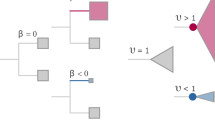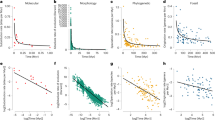Abstract
The two central elements of neo-darwinian evolution1,2 are small random variations and natural selection. In Wright's view, these lead to random drift of mean population characters in a fixed, multiply peaked ‘adaptive landscape’, with long periods spent near fitness peaks3,4. Using recent theoretical results5, we show here that transitions between peaks are rapid and unidirectional even though (indeed, because) random variations are small and transitions initially require movement against selection. Thus, punctuated equilibrium6,7, the palaeontological pattern8,9 of rapid transitions between morphological equlibria, is a natural manifestation of the standard wrightian evolutionary theory and requires no special developmental, genetic or ecological mechanisms10–13.
This is a preview of subscription content, access via your institution
Access options
Subscribe to this journal
Receive 51 print issues and online access
$199.00 per year
only $3.90 per issue
Buy this article
- Purchase on Springer Link
- Instant access to full article PDF
Prices may be subject to local taxes which are calculated during checkout
Similar content being viewed by others
References
Mayr, E. Animal Species and Evolution (Harvard University Press, 1963).
Lewontin, R. C. The Genetic Basis of Evolutionary Change (Columbia University Press, New York, 1974).
Wright, S. Proc. 6th int. Congr. Genet. Vol. 1, 356–366 (1932).
Wright, S. Evolution and the Genetics of Populations Vol. 3, 443–473: Vol. 4, 460–476 (University of Chicago Press, 1977, 1978).
Kipnis, C. & Newman, C. M. SIAM J. appl. Math. (in the press).
Eldredge, N. & Gould, S. J. in Models in Paleobiology (ed. Schopf, T. J. M.) 82–115 (Freeman, San Francisco, 1972).
Gould, S. J. & Eldredge, N. Paleobiology 3, 115–151 (1977).
Simpson, G. G. Tempo and Mode in Evolution (Columbia University Press, New York, 1944).
Simpson, G. G. The Major Features of Evolution (Columbia University Press, New York, 1953).
Hoffman, A. Evol. Biol. 15, 411–436 (1982).
Maynard Smith, J. A. Rev. Genet. 17, 11–25 (1983).
Geiger, G. Math. Biosci. 67, 59–79 (1983).
Kirkpatrick, M. Am. Nat. 119, 833–848 (1982).
Lande, R. Evolution 30, 314–334 (1976).
Galves, A., Olivieri, E. & Vares, M. E. Ann. Probabil. (submitted).
MacBean, I. T., McKenzie, J. A. & Parsons, P. A. Theor. appl. Genet. 41, 227–235 (1971).
Kellogg, D. E. Paleobiology 1, 359–370 (1975).
Parsons, P. A. The Evolutionary Biology of Colonizing Species (Cambridge University Press, 1983).
Wright, S. in Genetics, Paleontology and Evolution (eds Jepsen, G. L., Mayr, E. & Simpson, G. G.) 365–389 (Princeton University Press, 1949).
Ginzburg, L. Paleobiology 7, 426–429 (1981).
Petry, D. Paleobiology 8, 56–66 (1982).
Bookstein, F. L., Gingerich, P. D. & Kluge, A. G. Paleobiology 4, 120–134 (1978).
Barton, N. H. & Charlesworth, B. A. Rev. Ecol. Systematics 15, 133–164 (1984).
Fisher, M. E. Physics 3, 255–283 (1967).
Langer, J. S. Ann. Phys. 41, 108–157 (1967).
Faris, W. G. & Jona-Lasinio, G. J. Phys. A15, 3025–3055 (1982).
Newman, C. M. & Schulman, L. S. J. statist. Phys. 23, 131–148 (1980).
Author information
Authors and Affiliations
Rights and permissions
About this article
Cite this article
Newman, C., Cohen, J. & Kipnis, C. Neo-darwinian evolution implies punctuated equilibria. Nature 315, 400–401 (1985). https://doi.org/10.1038/315400a0
Received:
Accepted:
Issue Date:
DOI: https://doi.org/10.1038/315400a0
This article is cited by
-
Developing resilience to naturally triggered disasters
Environment Systems and Decisions (2015)
-
Oligomorphic dynamics for analyzing the quantitative genetics of adaptive speciation
Journal of Mathematical Biology (2011)
Comments
By submitting a comment you agree to abide by our Terms and Community Guidelines. If you find something abusive or that does not comply with our terms or guidelines please flag it as inappropriate.



